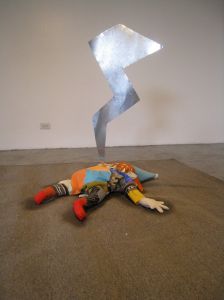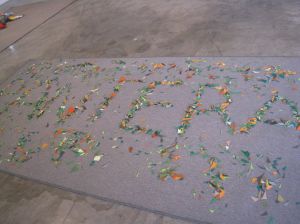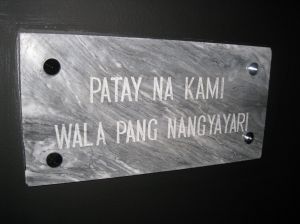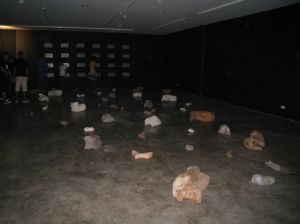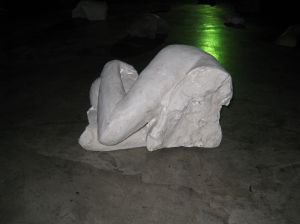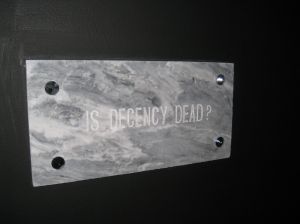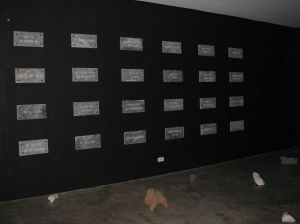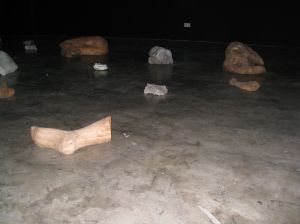The appeal of Lena Cobangbang’s show, Velvet Landings, now on its last few days at MO Space in Bonifacio High Street, comes from its quirkiness. What strikes me as various tableaux lie spread out over the gallery’s main space, each scene set atop a rectangular light brown carpet. They all possess the appearance of grade school art projects—raw and handmade, the antithesis of the slick and sleek industrial pieces produced in the workshops of say, Damien Hirst and Jeff Koons. You see the humor in the construction of Lena’s pieces, in her use of
accessible materials, readily available from National Bookstore.
What does not become apparent until you read the notes provided by the gallery is that they pertain to landings. Sort of. A Thousand, A Thousand, A Thousand…(Schema After Rilke) takes inspiration from the poem by Rainer Maria Rilke that describes a panther trapped in a cage. Lena has camouflaged a stuffed panther in orange and green felt strips, cut to simulate grass. When ready to pounce, a panther lands quick and quiet on its feet.
A lightning bolt strikes down a floppy harlequin in The Speed Of The Last Clap, metaphor for a joke that falls flat. In A Cloud That’s Flat Of Angles, you see the figure of a beast scorched on the carpet, as if it had been squashed and has left its imprint.
I can’t pretend to understand all of Lena’s work. I don’t really know how the colored felt strips (the same ones used to cover the panther) scattered to spell out “Pantera” in The Art Of Shredding fits in. Or even Woolwood, where she rolled up one of the
carpets to simulate a felled log with a small growth of greens. For Ravishing Colossus, installed inside the gallery’s small room, she worked with wax drips to put together a group of cone shapes that mimicked snowcapped mountains; they emit a neon glow when hit by black lights.
I first saw Lena’s work two years ago at the 2008 Singapore Biennale (See this blog’s archives, October 2008). Terrible Landscapes documented through photographs her recreations of disaster areas using food. Even then she had built miniature tableaux using everyday materials in a most unexpected manner: parsley sprigs turned into foliage, slices of blue cheese stood in for wrecked homes. Just as it was for those pieces, what registers with Lena’s newest work is her departure from the usual art exhibit offerings—kooky, but definitely not boring.
Velvet Landings runs until 26 September 2010 at MOs Space, Bonifacio High Street, Taguig. Phone (632) 856-2748 or visit http://www.mo-space.net
http://www.youtube.com/watch?v=ugIDse_hv0o



